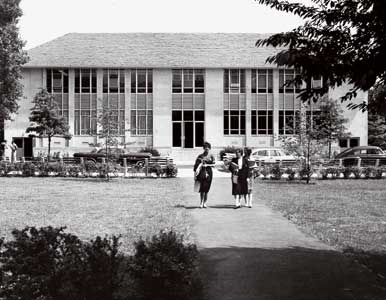
1920: AU debuted its School of Diplomacy, Jurisprudence, and Citizenship, offering classes in international relations, law, logic, world religions, anthropology, and economics at 1907 F Street. The inaugural class was composed of 57 students, including a handful of women, from as far away as the Philippines. Twenty years later, AU president Hurst Anderson and Bishop Bromley Oxnam began exploring the idea of establishing a school of international service. A $1 million gift from the Methodist Church in 1956 would help make the dream a reality.
1957: On a warm June evening at the height of the Cold War, President Dwight D. Eisenhower thrust a shovel into a patch of dirt on the quad and declared, "The waging of peace demands the best we have." And with that, AU's School of International Service (SIS) was born. The following year, SIS opened its doors to an inaugural class of 80 full-time students from 36 countries. Sixty years later, SIS is the largest school of international relations in the United States, with nearly 3,000 students from 130 nations.
1967: Named for SIS founding dean Ernest Griffith's father-in-law, Congressman Frederick Davenport, the Davenport Memorial Room was home to a chapel. But two years after the Kay Spiritual Life Center opened in 1965, the room was converted into a different sort of sacred space. Adorned with well-worm maps and an altar-turned-coffee table, the Davenport lounge offered newspapers from around the globe and 20-cent cups of joe. Three decades later, the menu has expanded to include exotic espresso drinks like the honey Bee-yonce latte (with proceeds going to SIS's Beekeeping Society), ,and most everyone is reading the day's news on their iPhones. Still, the student-run Dav remains the heartbeat of SIS.
2010: In May SIS moved into new digs on the last remaining free corner of the quad. The 70,000-square-foot building, the first on the AU campus to earn LEED Gold certification, represents SIS's commitment to ecological stewardship and social justice. "The founders of SIS would be proud of what we've done here," said then-dean Louis Goodman during the ribbon cutting. "It's a privilege to steward their vision, and I hope the people that follow us will be proud of what we've done."